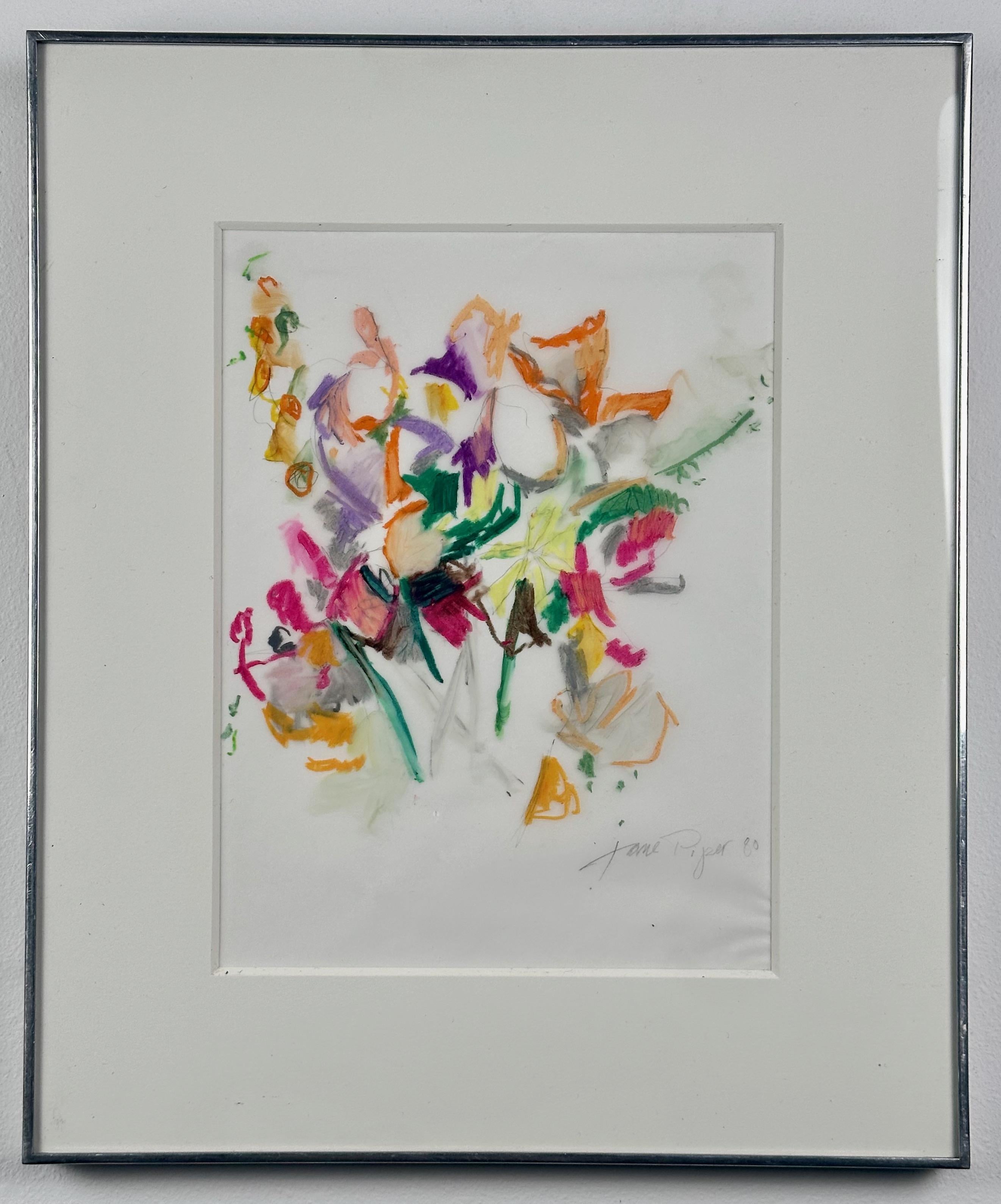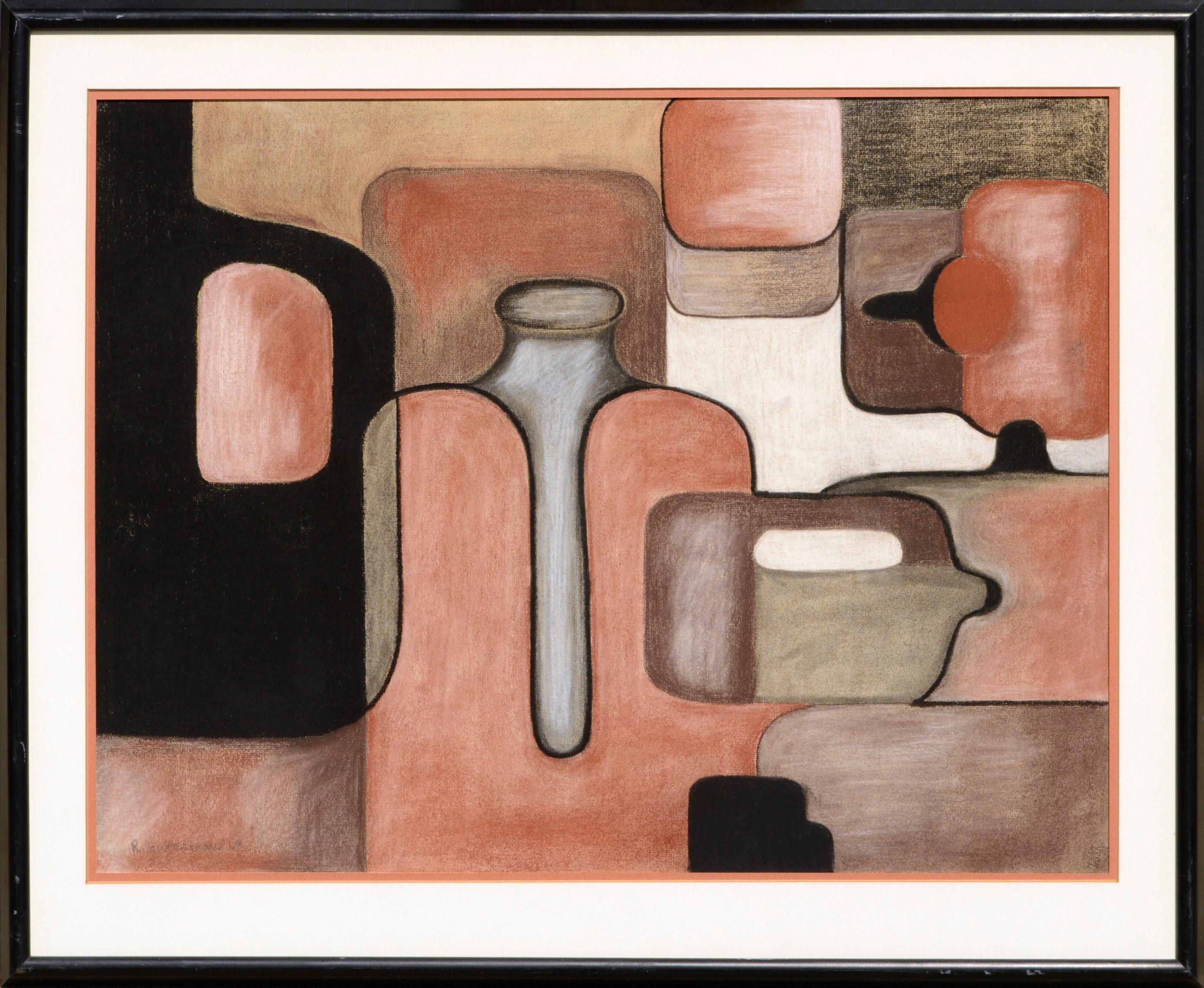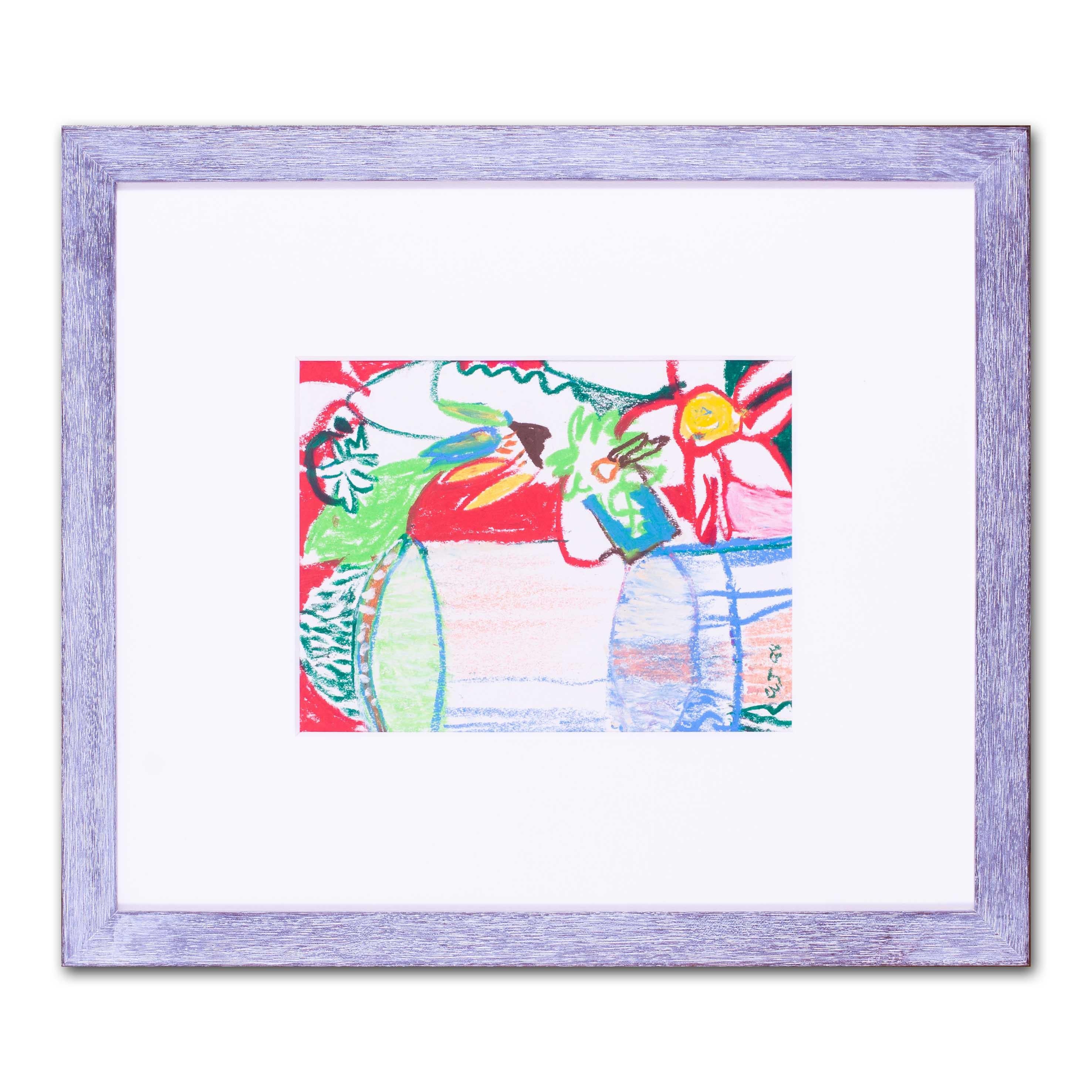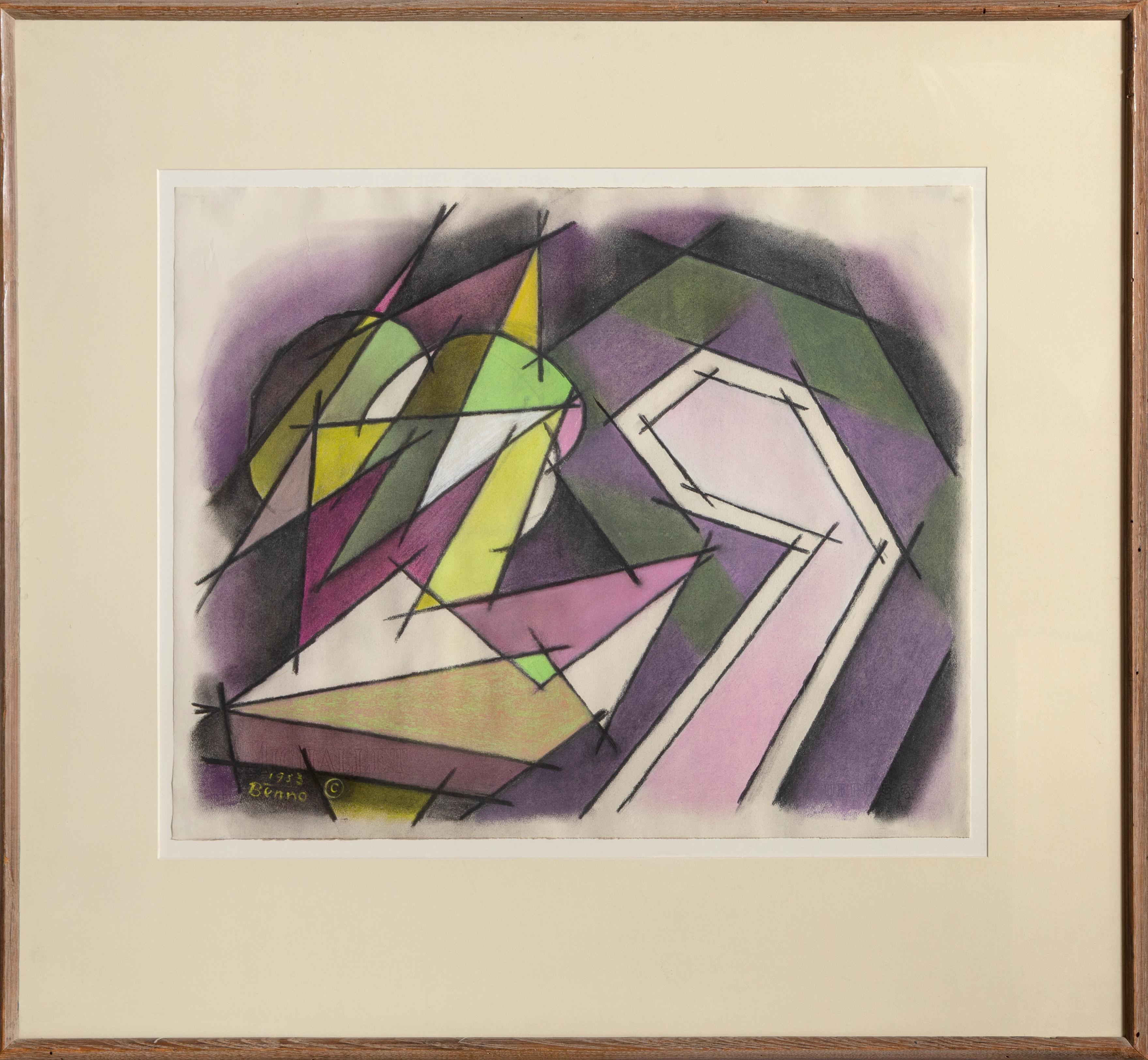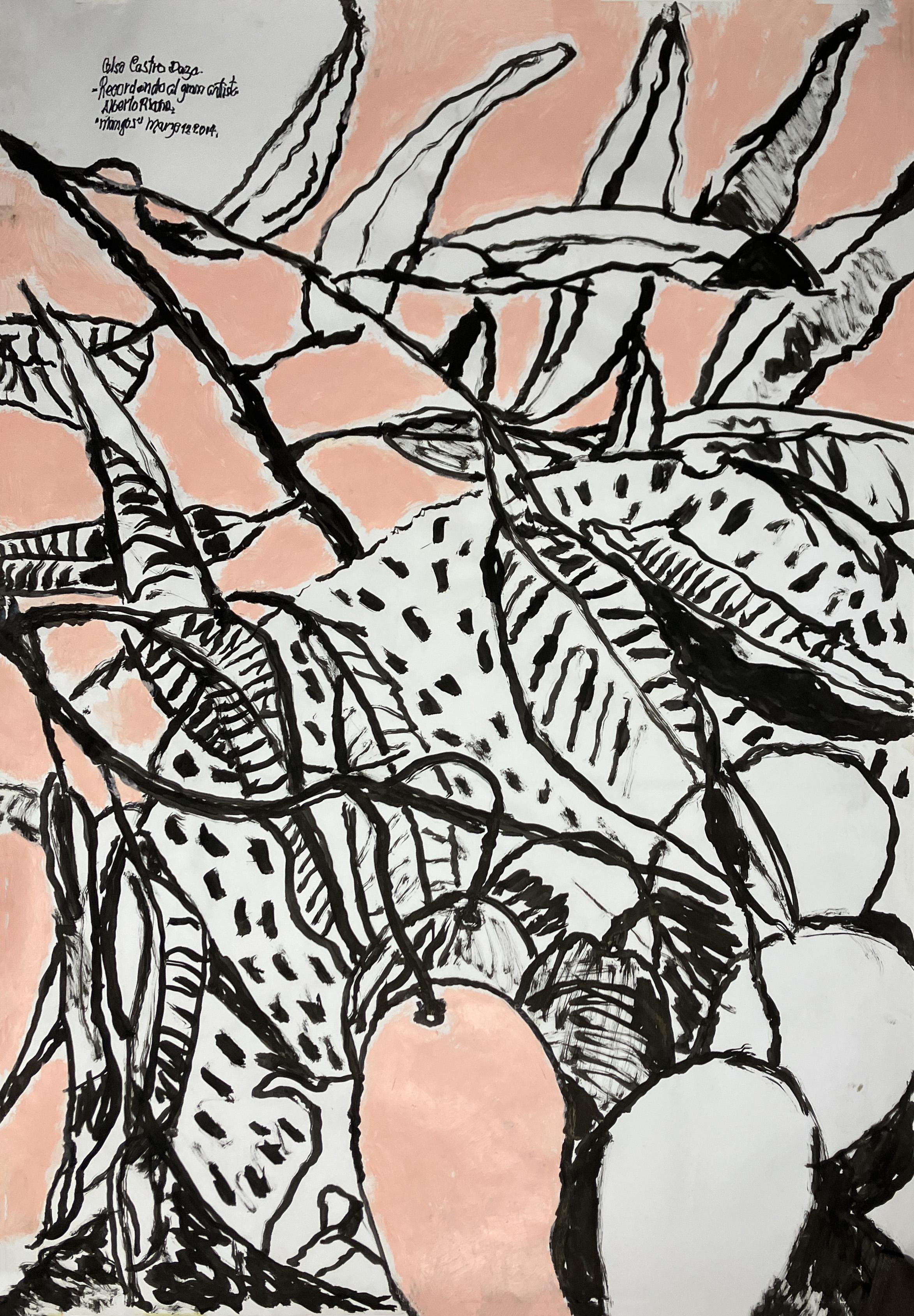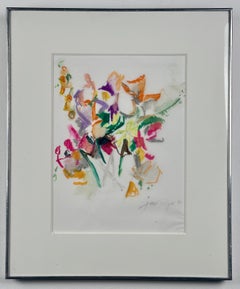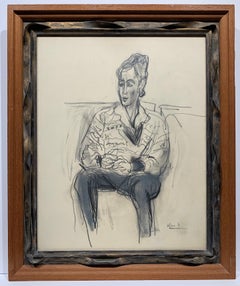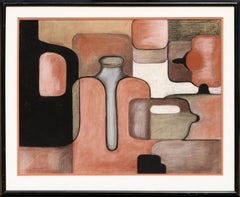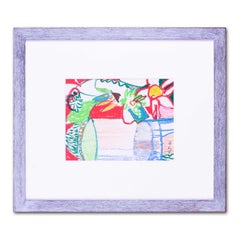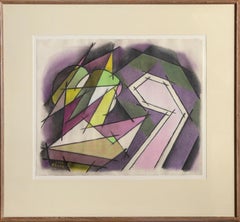Items Similar to Untitled Floral Still Life
Want more images or videos?
Request additional images or videos from the seller
1 of 11
Jane PiperUntitled Floral Still Life1980
1980
About the Item
Beautiful floral still life by American artist Jane Piper (1916-1991) . Pastel, oil crayon and pencil on tracing paper. Image measuring 13 x 15.5 inches in original frame measuring 20 x 23 inches. Signed and dated lower right.
Jane Gibson Piper (1916–1991) was an American artist known for her abstract treatment of still lifes. Building on the French modernist tradition of Matisse and Cézanne, she gave color precedence over representation.[2] Shortly after her death a critic said "throughout her career Piper worked within a relatively narrow aesthetic range. She was interested in spatial organization and in creating space through color — concerns of another painter she admired, Henri Matisse. There's a sense of Matisse in her later work, but no indication that she was trying to imitate him; the resonance reflects shared concerns."[3] From her first exhibition in 1943 through the end of her life she was given a total of thirty-four solo exhibitions in Philadelphia, New York, and other East Coast galleries and her works have been collected by major museums including the Philadelphia Museum of Art, the Pennsylvania Academy of the Fine Arts, the Brooklyn Museum, the National Academy of Design, The Phillips Collection, and the Carnegie Museum of Art.[4]
Early life and training
Piper was raised in a prosperous and well-connected Philadelphia family.[5] At the age of nine she spent a year at a pension in Cannes where, observing an amateur artist at work, she became infatuated with painting and afterwards convinced her reluctant father to enroll her in an art class.[6]: 79 [note 1] After a few years' study under the Philadelphia artist Grace Gemberling, she was able to study art as a boarder in a private school for girls, Westover School in Middlebury, Connecticut.[7]: 7 [8][9] Graduating in 1935, she returned to Philadelphia where she studied at the Pennsylvania Academy of the Fine Arts, first under Daniel Garber, whom she found to be too authoritarian, and then under Arthur Carles whose instruction she felt to be the most useful of all her teachers and whose artistic influence remained with her for the rest of her career.[6]: 79–80 [10] In 1936 she also enrolled for private study with the artist and collector Earl Horter. In his studio, her frequent close contact with paintings by Picasso, Braque, and Matisse made her aware of new possibilities in her own work.[7]: 12 [note 2] The influence of French Modernism on her work was also enhanced by informal study in Paris in 1937 and periods of study in the Barnes collection in 1938.[7]: 9–10 [note 3] Three years later she spent the summer months at the school Hans Hofmann conducted in Provincetown, Massachusetts.[7]: 12 [note 4] Piper appreciated Hofmann's instruction but preferred Carles's.[7]: 12 [note 5]
Exhibitions and critical reception
Although Piper was a productive artist, fiercely devoted to her work, she had no need of income from sales and showed as frequently in non-commercial as commercial galleries.[12]: 20 [13] Her first appearance in a public exhibition occurred in 1931 when a painting of hers was included in a children's art show at a Philadelphia women's cultural organization called the Plastic Club. Grace Gemberling mounted the show to put works by her young students on display. Piper's contribution was in a set of pictures on the theme of jealousy. Reviewing the show, C. H. Bonte of The Philadelphia Inquirer found the work in general to be natural and spontaneous and the jealousy set in particular to be emotionally overwhelming.[14]
Jane Piper, "Composition in Red," 1942-43, oil on masonite, 28 x 36 inches
Piper's unnamed and unsigned painting of 1942-43, called "Composition in Red," indicates the style of her work at the beginning of her professional career. During her career she participated in exhibitions held by non-commercial organizations included group and solo shows at the Philadelphia Art Alliance, Pennsylvania Academy of Fine Arts, Woodmere Art Museum, Philadelphia Arts Festival, Philadelphia Center for Architecture, Cheltenham Art Center, Wallingford Community Center, and galleries in Friends' Central School, Swarthmore College, Lehigh University and New York Studio School.[note 6] A traveling exhibition, "Jane Piper: Retrospective Paintings, 1940–1985," was first mounted in James Madison University in 1985.[15] In 1943 Piper was given her first appearance in a commercial gallery. Remarkably, this debut was a solo exhibition. The venue was the Robert Carlen Gallery in Philadelphia.[24] She was given a second solo show at Carlen in 1959.[15] Her first solo exhibition in a New York commercial gallery was at the Bonestell Gallery in 1947.[25] Other commercial solo shows included the Dubin Gallery (Philadelphia, 1954),[26] Parma Gallery (New York, 1958),[27] Cherry Stone Gallery (Wellfleet, Mass., 1971),[15] Bodley Gallery (New York, 1981),[15] Mangel Gallery (Philadelphia, 1987),[28] and Rising Tide Gallery (Wellfleet, Mass., 1990).[15] Beginning in 1971, she also had eight solo exhibitions at the Gross-McCleaf Gallery in Philadelphia.[15] Throughout the course of her career, Piper was given thirty-four solo exhibitions in commercial and non-commercial galleries in Philadelphia, New York, and Cape Cod.[4][29]
Jane Piper, Untitled, 1961, oil on canvas, 28 x 34 inches
Piper's untitled painting of 1961 indicates the non-objective style of her work late in her career.
Critical reception of Piper's work was at first tepid but grew stronger as her career progressed. Reviewing her first show in 1943, a critic complained that the paintings were overly-abstract and decorative, "admirably adapted for the adornment of modern rooms."[24] In 1956 her paintings received praise as "poetic light-filled abstractions."[18] At the height of her career in 1983 a reviewer found that "her abiding lyrical connection with nature and the domestic environment, and pursuit of a unique, individual perception, place her firmly within a strong American tradition, although she remains spiritually separate from any trend or movement."[30] A few years later she was recognized for an "original, daring approach" that was "firmly in the tradition of great American still life painting."[19]
Jane Piper, "Fruit and Flowers," 1974, acrylic and charcoal on canvas, 40 x 60 inches
Piper's "Fruit and Flowers of 1974 shows her handling of objects in an abstract style.
In 1986 a curator who had organized a retrospective exhibition of her work wrote that "she retains a sense of wonder while developing ever new complex harmonies of form and color"[31] and a reviewer, calling Piper one of Philadelphia's best artists, said her paintings "with her preference for yellow, orange and red tints and clear blues and greens, give an original picture of her domestic environment and nature's bounty and profuse growth." This critic continued: "Clearly, this gifted artist has had success creating a living and working environment that has a direct relationship to her creative life as an artist."[32] In 2010, nineteen years after her death, Piper was called "one of Philadelphia's finest painters"[29] and three years later she was called "one of Philadelphia's most prominent modernist painters."[33]
Artistic style and working methods
Her technique is modern. She abstracts through color her own essence of still life. Yet what is interesting and fulfilling about her work is that her original, daring approach is firmly in the tradition of great American still life painting.
—Victoria Donohoe, "Hard Decisions That Pay Off in an Artist's Constructions," The Philadelphia Inquirer, October 17, 1986[19]
In addition to the pervasive influence of her mentor Carles, Piper's early paintings were said to show the influence of Matisse and Cézanne. The influence of Carles and Matisse persisted as well in her late and final work.[9][34] Color appears as the organizing principle in most of her paintings from the first to the last.[2] Although constant reworking made it difficult to discern, her paintings were infrequently purely abstract.[30] In fact she was primarily a still life painter and almost always used objects in her studio as a starting point for each work.[19] Late in her career, a critic noted that her paintings were neither "abstract" nor "figurative," but something in between.[32] She herself said, "I was never conscious of painting representationally or not painting representationally. I was always involved in spacial forms, which naturally lead you somewhat into abstraction. You have to handle your responses to what you're seeing. I was putting down what I saw and how I felt about what I found as connecting links."[6]: 122
In her work Piper wished to express her emotions rather than give a pictorial narrative.[31] At the height of her career she responded to the poems of Wallace Stevens valuing the way in which they expressed emotions "in a moment's clarity of thought."[9][note 7]
In addition to rich colors, her mature work was noted for her use of white pigment,[19][31][35] which she used as negative space in order to better define her subjects.[10] She was said, like Matisse, to be "interested in spatial organization and in creating space through color,"[3] and a critic appreciated her late paintings for the "space structured by color, using still-life motifs" that they conveyed.[29] Early in her career most of Piper's paintings were made in oil on canvas. Later, she mainly used acrylic colors which she liked because of the quality of the whites. The shorter drying time was also important to her as she repainted continually as her paintings evolved.[6]: 78
A private person who worked in solitude, she worked intensely, believing, as Carles had maintained, that in painting "you put everything in your life into it."[36] Speaking of students she had taught, she said it took more than just talent to sustain a professional career: "You must be able to tolerate yourself for long periods of time, working in the isolation of a studio."[6]: 122 She was unusually disciplined and rarely took time off. Despite family responsibilities (raising two daughters and moving the family about as her husband's career evolved), she once said a six-month hiatus was the longest time she had spent out of the studio.[6]: 122 [12]: 20 "Observers should feel that the act of painting was effortless – that it happened, it just happened," she said in a 1977 magazine interview. "Which of course," she added, "is not true."[4] A few years later she said, "Painting is a pleasure, even though painful. It will always be a pleasure for me, because it is the thing I want to do the most."[7]: 17
Collections
Piper's paintings are held in the permanent collections of the Philadelphia Museum of Art, Pennsylvania Academy of Fine Arts, Brooklyn Museum, Carnegie Museum of Art, National Academy of Design, Phillips Collection, Provincetown Art Museum, Mount Holyoke College Art Museum, and Woodmere Art Museum.[4][23][33]
Art teacher
She taught painting and drawing at the Philadelphia Museum of Art in the mid-1950s. From 1956 to 1985 she taught at the Philadelphia College of Art.[4] She also taught at the Pennsylvania Academy and the New York Studio School.[29] Of her teaching method she said, "In teaching I relate to the students one to one. I try to wait until they've done something, and then I talk to them about what they've done. I think they get much more from the setups or from looking at other paintings than they do from a lecture."[6]: 122
Personal life and family
Piper was born in Philadelphia on August 21, 1916.[15] Her father was Edmund B. Piper and her mother Elizabeth Gibson Piper. They were married in 1906 and settled in Williamsport, Pennsylvania.[37] Her grandparents on her father's side were members of an old and prominent family of Watsontown and neighboring Williamsport.[38] On her mother's side her grandparents were prosperous Williamsport merchants.[39] Edmund B. Piper was a well-known obstetrician and gynecologist who gained recognition for a forceps he designed (and which bears his name).[40] Elizabeth Gibson Piper led an active social life, her name appearing frequently in the society columns of The Philadelphia Inquirer. Piper had two older sisters, Helen E. and Eleanor L. Piper.[41] In 1925, Piper's mother and the three girls, aged eighteen, fifteen, and nine, spent the winter in France and it was there, at a pension in Cannes, that Piper decided she would become an artist.[6]: 79 [42] During the winter of 1933–34, following the elaborate activities required for the introduction to society of Helen and Eleanor as well as Helen's marriage to Henry B. Coxe, Piper's mother again took the three daughters to France.[42][43][44] In the meantime, the three had been names as principal beneficiaries in the will of a wealthy maiden aunt, Elizabeth L. Piper, each to receive $30,000 on their eighteenth birthdays,[13][45] and Piper had become a boarding student at Westover School in Middlebury, Connecticut.[46] In February 1935 Piper's father died at the age of fifty-four,[47] in May she graduated from Westover, and in November she was honored as a débutante when a Bachrach portrait appeared in the society pages of The Philadelphia Inquirer.[1][48] During the remaining years of the 1930s she was an active participant in Philadelphia society, participating in a charity ball,[49] being a bridesmaid in wedding ceremonies,[50] joining the Junior League, and entertaining friends at her mother's summer place in Eagles Mere.[51]
Piper was twenty-six when she married a Navy aviation cadet, E. Digby Bartzell, Jr., in the winter of 1943.[52] His family, like hers, was prominent in Philadelphia society and, like her, he had attended prestigious private boarding school. Subsequently he had obtained Ivy League undergraduate and graduate degrees and, following service as a military intelligence officer in the South Pacific, had become a highly-respected professor of sociology.[53][note 8]
Piper kept her maiden name for professional uses and her married name for other uses. She and Baltzell had two daughters, Eve, born in 1944, and Jan, born in 1948.[note 9] Following his discharge from the Navy in 1945, the young family moved from place to place as Baltzell's career evolved.[note 10] In 1963 Piper and Baltzell began spending summers in Wellfleet on Cape Cod and two years later, having bought a house there, Piper built a studio on the property.[7]: 13–14
Piper died on August 8, 1991, at age 74, and was buried in Philadelphia's Woodlands Cemetery.[33][55] Baltzell died in Boston at age 80 on August 17, 1996.[23][56]
- Creator:Jane Piper (1916 - 1991, American)
- Creation Year:1980
- Dimensions:Height: 20 in (50.8 cm)Width: 24 in (60.96 cm)Depth: 1 in (2.54 cm)
- Medium:
- Movement & Style:
- Period:
- Condition:
- Gallery Location:Wilton Manors, FL
- Reference Number:1stDibs: LU245214290942
About the Seller
4.9
Platinum Seller
Premium sellers with a 4.7+ rating and 24-hour response times
Established in 2007
1stDibs seller since 2015
387 sales on 1stDibs
Typical response time: 3 hours
- ShippingRetrieving quote...Shipping from: Wilton Manors, FL
- Return Policy
Authenticity Guarantee
In the unlikely event there’s an issue with an item’s authenticity, contact us within 1 year for a full refund. DetailsMoney-Back Guarantee
If your item is not as described, is damaged in transit, or does not arrive, contact us within 7 days for a full refund. Details24-Hour Cancellation
You have a 24-hour grace period in which to reconsider your purchase, with no questions asked.Vetted Professional Sellers
Our world-class sellers must adhere to strict standards for service and quality, maintaining the integrity of our listings.Price-Match Guarantee
If you find that a seller listed the same item for a lower price elsewhere, we’ll match it.Trusted Global Delivery
Our best-in-class carrier network provides specialized shipping options worldwide, including custom delivery.More From This Seller
View AllUntitled Floral Still Life
Located in Wilton Manors, FL
Beautiful floral still life by American artist Jane Piper (1916-1991) .
Untitled. 1980.
Pastel, oil crayon and pencil on tracing paper. Image measuring 9 x 12 inches in original ...
Category
1980s Abstract Still-life Drawings and Watercolors
Materials
Parchment Paper, Crayon, Pastel, Pencil
$1,200 Sale Price
40% Off
Still Life (New Hope Mid-century Modernist drawing)
By Lloyd Raymond Ney
Located in Wilton Manors, FL
Beautiful still life drawing by American artist, Lloyd Raymond Ney (1893-1964). Ink on paper, 14.5 x 21 inches; 25.5 x 31.5 inches framed. Excellent condition with no damage or restoration. Signed lower right.
Birth place: Friedenburg, PA.
Addresses: New Hope, PA, 1925-64
Profession: Painter, lecturer, teacher
Studied: PAFA with H. McCarter, 1914 -18 (Cresson Scholarship; traveled in Europe 1918-21; Paris in 1924)
Exhibited: AIC, 1937; Guggenheim Museum, 1941-56; PAFA Ann., 1941, 1951; numerous group shows in Europe.
Work: Guggenheim Museum, NYC. WPA commission, 1941, mural for New London, Ohio Post Office (Citizens of New London petitioned WPA administrator Edward Bruce to allow Ney to paint the mural)
Comments: Abstract painter. He spent many years in Paris, where he was friendly with Pascin, Foujita, Frieske, H.O. Tanner, W. Pach and Roger Fry...
Category
1950s Abstract Still-life Drawings and Watercolors
Materials
Ink
Portrait of Aiko
Located in Wilton Manors, FL
Seiichi Hara (Japanese). Portrait of Aiko, 1972. Pencil, gouache on paper. Sheet measures 16 x 20 inches. Signed lower right and en verso. Custom frame of hardwood with welded steel ...
Category
1970s Abstract Abstract Drawings and Watercolors
Materials
Paper, Gouache, Pencil
Untitled Modernist (Abstract Expressionist Figurative Painting)
Located in Wilton Manors, FL
Beautiful Abstract expressionist figure signed Kline. Charcoal on paper measuring 10 x 13 inches. Sheet is glued down to foam board backing. Total measurement 13 x 16 inches.
Category
Mid-20th Century Abstract Expressionist Abstract Drawings and Watercolors
Materials
Paper, Ink
Hesitation Blues (Black Surrealist Artist)
By Roland Ayers
Located in Wilton Manors, FL
Surrealist proto-Afropunk drawing by African-American artist, Roland Ayers (1932-2014). Hesitation Blues, 1968. Ink on paper, sheet measures 13 x 23 inches; 14 x 18 inches in archival pH-neutral matting. Signed and dated lower right. Excellent condition with no damage or restoration.
Provenance: Sheila Ayers-Whitelaw
Exhibition History: Roland Ayers: Calligraphy of Dreams, Woodmere Art Museum, 07/10/2021 - 10/24/2021
Artist and art educator, Roland Ayers was born on July 2, 1932, the only child of Alice and Lorenzo Ayers, and grew up in the Germantown district of Philadelphia. Ayers served in the US Army (stationed in Germany) before studying at the Philadelphia College of Art (currently University of the Arts). He graduated with a BFA in Art Education, 1954. He traveled Europe 1966-67, spending time in Amsterdam and Greece in particular. During this period, he drifted away from painting to focus on linear figurative drawings of a surreal nature. His return home inaugurated the artist’s most prolific and inspired period (1968-1975). Shorty before his second major trip abroad in 1971-72 to West Africa, Ayers began to focus on African themes, and African American figures populated his work almost exclusively.
In spite of Ayers’ travel and exploration of the world, he gravitated back to his beloved Germantown, a place he endowed with mythological qualities in his work and literature. His auto-biographical writing focuses on the importance of place during his childhood. Ayers’ journals meticulously document the ethnic and cultural make-up of Germantown, and tell a compelling story of class marginalization that brought together poor families despite racial differences. The distinctive look and design of Germantown inform Ayers’ visual vocabulary. It is a setting with distinctive Gothic Revival architecture and haunting natural beauty. These characteristics are translated and recur in the artist’s imagery.
During his childhood, one of the only books in the Ayers household was an illustrated Bible. The images within had a profound effect on the themes and subjects that would appear in his adult work. Figures in an Ayers’ drawing often seem trapped in a narrative of loss and redemption. Powerful women loom large in the drawings: they suggest the female role models his journals record in early life. The drawings can sometimes convey a strong sense of conflict, and at other times, harmony. Nature and architecture seem to have an antagonistic relationship that is, ironically, symbiotic.
A critical turning point in the artist’s career came in 1971 when he was included in the extremely controversial Whitney Museum show, Contemporary Black Artists in America. The exhibition gave Ayers an international audience and served as a calling card for introductions he would soon make in Europe.
Ayers is a particularly compelling figure in a period when black artists struggled with the idea of authenticity. A questioned often asked was “Is your work too black, or not black enough?” Abstractionists were considered by some peers to be sell-outs, frauds or worse. Figurative* work was accused of being either sentimental or politically radical depending on the critical source. Ayers made the choice early on to be a figurative artist, but considered his work devoid of political content.
Organizations such as Chicago’ s Afri-Cobra in the late 1960‘s asserted that the only true black art of any relevance must depict the black man and woman...
Category
1960s Surrealist Abstract Drawings and Watercolors
Materials
Ink, Archival Paper
Nude Study
By Federico Castellon
Located in Wilton Manors, FL
double-sided c.1950's drawing by Spanish artist, Federico Castellon (1914-1971). Ink on wove paper, sheet measures 10 x 13 inches; 21.5 x 24.5 inches in wood frame. Excellent condition with no restoration or damage. Signed with artist's chop in red ink seal that he used in Asia. From a recently discovered collection of over 60 important Castellon drawings and watercolors c.1939-1950.
Birth place:
Almeria, SpainDeath place: New York, NYAddresses: NYC (immigrated 1921; citizen, 1943)Profession: Painter, graphic artist, sculptor, etcher, illustrator, teacher
Exhibited:
Weyhe Gal., 1934, 1936-40; AIC, 1935-47 (prize, 1938); AFA traveling exh., 1937; WMAA, 1938-45; PAFA, 1938-39, 1940 (prize), 1941-42; Carnegie Inst., 1942; PAFA, 1943-53; Assoc. Am. Ar., 1946 (prize), 1952 (solo); Corcoran Gal, 1947; LOC, 1949 (prize); Paris, France, 1952; Bombay, India, 1952; Gallery 10, 1961; Dintenfass Gal., N.Y., 1963; Phila. Pr. Cl., 1964 (prize); Hudson Gld. A., 1964; Great Neck, L.I., 1964; SAGA, 1964 (prize). In 1953, under the auspices of State Dept. Specialist Div., of I.E.S., he exhibited in Venezuela, Colombia, Peru, Chile, Bolivia, Uruguay, Argentina, Paraguay, with lectures in each country.
Awards:
F., Spanish Republic, 1934-36; fellow, Guggenheim Fnd., 1941, 1950; Nat. Inst. A. & Let. Grant, 1950.
Member:
NA; SAGAWork: WMAA; PAFA; MoMA; PMA; MMA; BM; AIC; NYPL; LOC; Univ. KY; San Diego Mus. FA; Newark (NJ) Pub. Lib.; Princeton Univ. (Frank Jewett Mather Coll.).
Comments:
A Surrealist painter whose imagery of the 1930s was greatly influenced by Dali. His full name was Federico Cristencia de Castellón y Martinez. Teacher: Columbia Univ., 1946-61; Pratt Inst., Brooklyn, 1952-61. Illustrator: Shenandoah, 1941; I Went into the Country, 1941; Bulfinch's Mythology, 1948; The Story of Marco Polo, 1954; The Man Who Changed China, 1954; The Story of J. J. Audubon, 1955; The Little Prince, 1954; The Life of Robert L. Stevenson, 1954. Reproduction of paintings on The Sumerian Civilization" for Life series "The Epic of Man," 1956; 15 paintings on "The History of Medicine" for MD magazine, 1960-61; The Story of Madame Curie...
Category
Mid-20th Century Cubist Nude Drawings and Watercolors
Materials
Paper, Ink
$600 Sale Price
20% Off
You May Also Like
Abstract Geometric Terracotta Jugs, Mid Century Modern Abstracted Still Life
Located in Soquel, CA
Bold mid century modern abstracted pastel on paper still life of several terra cotta jugs and vessels distilled down to their most basic shapes and ar...
Category
1960s Abstract Geometric Abstract Drawings and Watercolors
Materials
Paper, Pastel
Vibrant abstract picture of jar and flowers by Modern British artist Ewart Johns
Located in Petworth, West Sussex
A beautiful and peaceful abstract still life painting done in pastel. Vibrant colours such as red, yellow, blue and green burst through the picture to create a living and loving peac...
Category
20th Century Abstract Abstract Drawings and Watercolors
Materials
Pastel
Still Life with Gray, Green, and Violet Cubist Drawing by Benjamin Benno 1953
By Benjamin G. Benno
Located in Long Island City, NY
An original pastel on paper by Benjamin Benno, American (1901 - 1980) measuring 19 x 25 inches. Nicely framed to 31 x 36 inches. By the early 1930s he had established a reputation ...
Category
1950s Cubist Still-life Drawings and Watercolors
Materials
Archival Paper, Pastel
Winnowing Basket (neutral patterned print)
By Angela A'Court
Located in New York, NY
Angela A’Court’s narrative and still life drawings use a simple and direct vocabulary to show the relationship of experience to expression of beauty and the quirkiness of every day moments. With an eye toward balance, the artist moves towards abstraction in "Winnowing Basket...
Category
2010s Contemporary Still-life Drawings and Watercolors
Materials
Mixed Media, Paper, Pastel
Recordando el gran artista Alberto Riano "Mangos" Marzo, Drawing
By Celso José Castro Daza
Located in Miami Beach, FL
Recordando el gran artista Alberto Riano Mangos Marzo, 2014 by Celso Castro
Black paint, and pastel on archival paper
Image size: 39.2 H in. x 28 in. W
Unframed
____________
Undefin...
Category
1990s Contemporary Abstract Drawings and Watercolors
Materials
Pastel, Archival Paper, Acrylic
Abstract Still Life with Lute
By Winold Reiss
Located in New York, NY
Pastel on black paper
Category
Early 20th Century Still-life Drawings and Watercolors
Materials
Paper, Pastel
Recently Viewed
View AllMore Ways To Browse
Life Is Short
Family Floral
General Life
Floral Still Life
Down Floral
Still Life With Picasso
20x20 Floral
1930s Still Life Paintings
1935 Still Life
Jane French
Matisse 1980
Picasso Untitled
Watercolor Fruit Still Life
Abstract Floral Watercolor
Painting Still Life In Style Of Matisse
Still Life Fruit Oil Painting French
Henri Matisse Signed Pencil
Still Life Yellow Fruit
